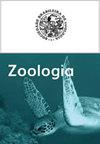The microanatomy of the central nervous system and brain of the Indo-Pacific seahorse, Hippocampus barbouri, during development
IF 1.8
4区 生物学
Q4 ZOOLOGY
引用次数: 0
Abstract
The central nervous system (CNS) of Teleostei is a complex system of self-governance and its morphology is reflected in the physiological and reproductive behaviors. The Indo-Pacific seahorse, Hippocampus barbouri Jordan & Richardson, 1908, is a new candidate species for aquaculture in Thailand. In this study, we investigated the brain morphology of H. barbouri across various developmental windows. Light microscopic observations of adult brains revealed a large optic tectum in the mesencephalon, whereas the cerebral hemispheres and the cerebellum are of medium size. The detailed brain structures were generally similar to those of other teleosts; however, only five distinct layers were present in the optic tectum, including the stratum marginale, stratum opticum, stratum album central, stratum griseum central, and stratum periventriculae, versus six layers observed in other fish. One day after birth (1 DAB) the brain was a packed structure without any clear sub-structures. The number of capillaries in the optic tectum began to increase at 6 DAB, and at 14 DAB several features, including small blood vessels in the optic tectum and Purkinje cells, became noticeable. By 35 DAB, the optic tectum became highly vascularized and included five layers. Additionally, large Purkinje cells were developed in the cerebellum. Based on the brain development pattern, we speculate that the predatory ability of this fish starts to develop from 6 to 14 days after birth.印度-太平洋海马发育过程中中枢神经系统和大脑的显微解剖
遥骨鱼的中枢神经系统是一个复杂的自我管理系统,其形态反映在生理和生殖行为中。印太海马,Hippocampus barbouri Jordan & Richardson, 1908,是泰国水产养殖的新候选物种。在这项研究中,我们通过不同的发育窗口研究了H. barbouri的大脑形态。成人大脑的光镜观察显示,中脑有一个大的视觉顶盖,而大脑半球和小脑则是中等大小。详细的大脑结构与其他硬骨鱼大体相似;然而,在视顶盖中只存在5个不同的层,包括边缘层、视顶盖层、视顶盖层中央层、视顶盖层中央层和脑室周围层,而在其他鱼类中观察到6个层。出生后一天(1 DAB),大脑是一个致密的结构,没有任何清晰的亚结构。在6 DAB时,视顶盖的毛细血管数量开始增加,在14 DAB时,一些特征,包括视顶盖的小血管和浦肯野细胞,变得明显。到35 DAB时,视神经顶盖高度血管化,包括五层。此外,在小脑中发育了大的浦肯野细胞。根据大脑发育模式,我们推测这种鱼的捕食能力在出生后6到14天开始发育。
本文章由计算机程序翻译,如有差异,请以英文原文为准。
求助全文
约1分钟内获得全文
求助全文
来源期刊

Zoologia
生物-动物学
自引率
0.00%
发文量
15
期刊介绍:
Zoologia, the scientific journal of the Sociedade Brasileira de Zoologia (SBZ), is an international peer-reviewed, open-access Zoological journal that publishes original research on systematics, evolution, taxonomy, nomenclature, biogeography, morphology, physiology, biology, ecology, symbiosis, conservation, behavior, genetics and allied fields. The journal, formerly known as Revista Brasileira de Zoologia, publishes original articles authored by both members and non-members of the Society. The manuscripts should be written exclusively in English.
 求助内容:
求助内容: 应助结果提醒方式:
应助结果提醒方式:


